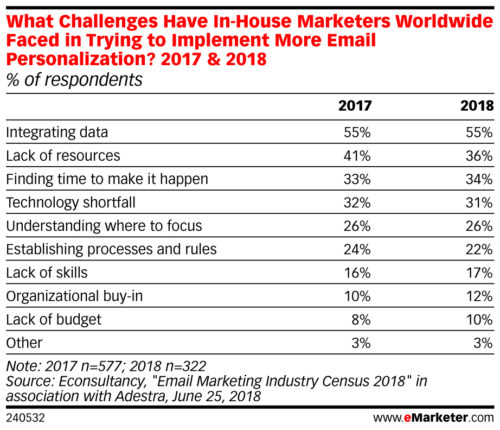
Demystifying the Next Gen ESP
What are your top personalization goals for the year ahead?
If you’re like most retail marketers, you have well-thought out, strategic goals for personalized marketing. But there’s likely a major roadblock standing between you and those goals: A lack of access to actionable data.
Retail Has a Data Activation Problem
With the rise of ecommerce, the retail space is ripe with data. Every time shoppers engage online and with various products, they leave behind an enormous trail of data about their interests and intent. However, all of this data has traditionally been spread and stored across various systems. Furthermore, in organizations where teams are organized by channel, data is typically managed by channel as well, versus holistically across channels for each customer.
This setup has created a dilemma for marketers when it comes to determining (a) who to target and (b) the best offer, product, content and copy to share with those individuals. Making those determinations is possible, but it requires working with several vendors and slicing and dicing data in ways that most teams simply don’t have the time or resources to handle.
As a result, retailers everywhere have found themselves with a data activation problem. They know the data exists and they know how to use it, they simply can’t access it — or do so in a way that makes it possible to take action based on it. In fact, eMarketer finds that integrating data presents the biggest challenge to implementing more email personalization for 55% of marketers worldwide.

Traditional Email Service Providers Don’t Solve Retail’s Data Activation Problem…
For most retailers, personalized marketing strategies center around email. It makes sense: Email remains the marketing channel with the highest return on investment and it offers the highest fidelity form of identification. Plus, because consumers must explicitly opt in to receive emails (and can opt out at any time), they receive emails only from the companies from which they want to hear.
It’s curious then, that traditional email service providers (ESPs) don’t solve retail’s data activation problem — the biggest roadblock standing between retail marketers and their personalization goals.
…Instead, They Solve the “Problem” of Sending Emails
Instead, these traditional ESPs solve for the problem of sending high volumes of email. But the truth is, that hasn’t actually been a problem for many years now.
Today, sending high volumes of email has become commoditized. At a time when retail marketers are leading with top-line goals and asking questions like who should I email, what should I send them and when should I send it — and looking for data to back them up — email service providers are still answering the question of how much email to send. Notably, they’re doing so because they get paid by volume, so these ESPs are incentivized to get retailers to send more emails (even though that can have negative implications for retailers, such as customer fatigue). As a result of this business model, traditional ESPs don’t think about enabling their clients for success by helping them send more personalized emails that produce the same or more revenue, since that personalization typically means sending fewer emails.
Sure, some email personalization is possible with these traditional ESPs, but it’s very basic. For example, these systems can bring in CRM data to create lists of people based on factors like region or other identifiers that shoppers have shared explicitly. But that’s it. They don’t offer any opportunities to go deeper into individual data, such as a shopper’s likelihood to buy from a certain category. They also don’t make recommendations on the best offers to get in front of individual shoppers.
To achieve that type of deep, 1:1 personalization with a traditional ESP, marketers must cobble together multiple technologies. That setup creates enormous complexities, not to mention inefficiencies, making it impractical and frustrating for many teams.
Enter the Next Gen Email Service Provider
The next generation ESP uses retail personalization to solve retail’s data activation problem (and then some) in a single solution. It does so by:
- Collecting customer, product and behavior data to allow for personalization based on implied interests as well as information shared explicitly
- Making all of that data accessible in a single AI-driven retail marketing platform
- Providing data driven insights that enable marketers to understand where to action next
- Improving access to actionable data and customer experience management tools that allow marketers to take action without worrying about how long it will take to put everything in motion
Essentially, the next gen ESP recognizes that sending email is no longer the problem that needs solving, so while it does making sending high volumes of email possible, that’s simply tablestakes. Its main focus is helping marketers act on data intelligence to grow and monetize their customer base.
As a result of this focus, the next gen ESP can help retail marketers solve a variety of different business problems. For example, it can use intent data from customer behaviors as well as their interactions with products to help increase customer retention, grow lifetime value, improve customer acquisition and reactivate lost buyers.
The Next Gen ESP Changes the Personalization Conversation
Ultimately, the next generation ESP allows marketers to take enormous steps forward in their personalization journey. It changes the conversation from “how do we put these personalization strategies into action?” and “where do we get started?” to “how can we make our personalization even smarter?”
This shift toward easier access to actionable data has already allowed leading retail marketing teams to successfully introduce and scale their personalized marketing. Consider the case of TrueFacet, the luxury watch and jewelry resale platform, which has tapped a next gen ESP to introduce AI-driven personalization to all of its emails. This approach allows the reseller to create personalized, timely campaigns across its massive catalog of products, creating a true competitive advantage.
Embracing the Next Gen Email Service Provider
What else do you need to know about the next gen ESP? And what does the process of embracing one look like? Find out everything you need to know in The Ultimate Guide to ESP Selection for the Modern Retail Marketer.






